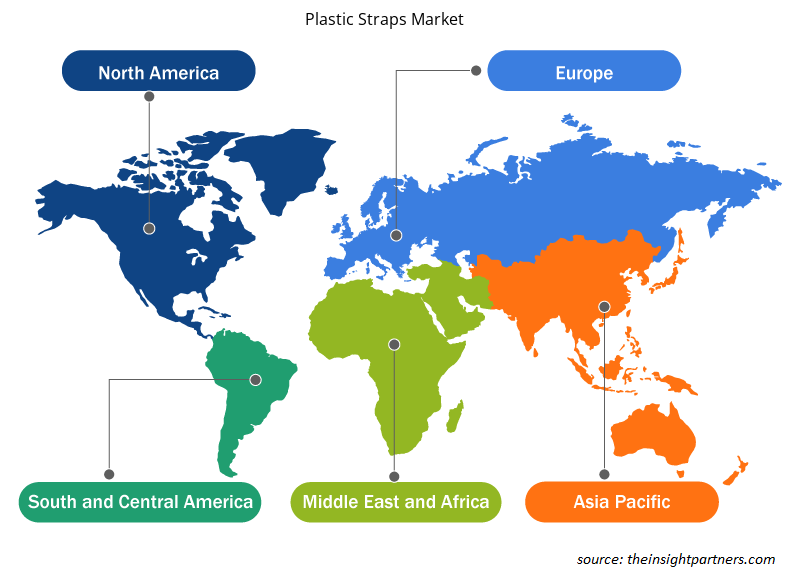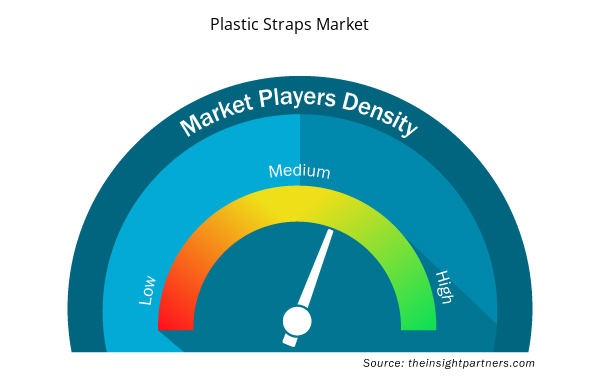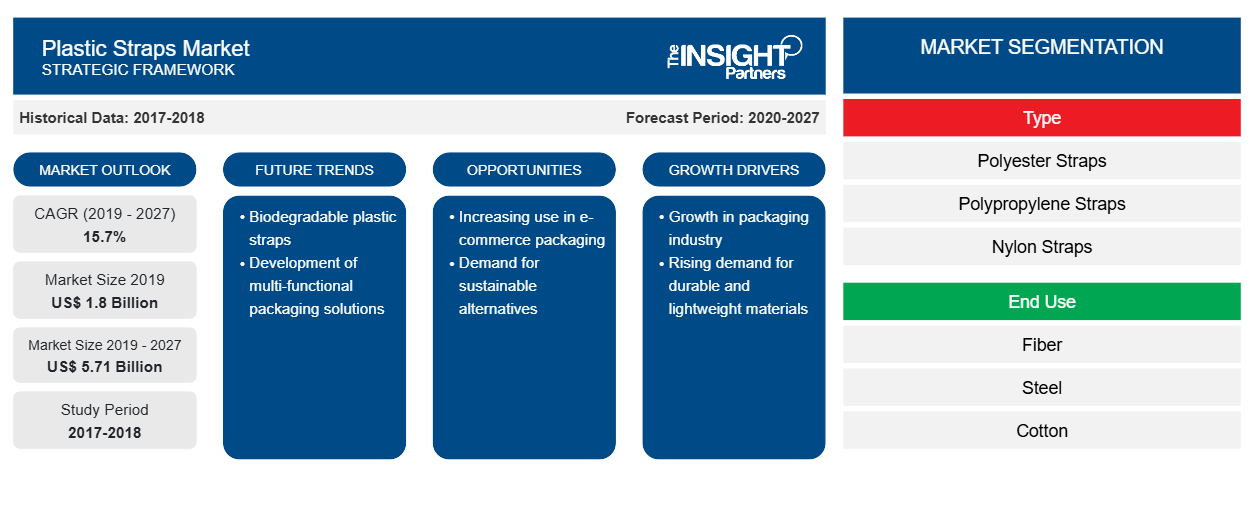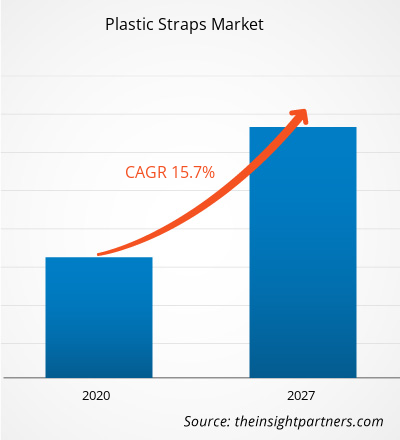[Rapporto di ricerca] Il mercato delle cinghie di plastica è stato valutato a 1.802,47 milioni di dollari nel 2019 e si prevede che raggiungerà i 5.714,12 milioni di dollari entro il 2027; si prevede che crescerà a un CAGR del 15,7% dal 2020 al 2027.
La domanda di cinghie di plastica sta crescendo a causa dell'impennata della domanda di imballaggi e logistica migliori in tutto il mondo. Inoltre, l'aumento dell'industria della carta e delle costruzioni offre un'opportunità di crescita per il mercato delle cinghie di plastica. Inoltre, la crescita del mercato delle cinghie di plastica è guidata dal crescente utilizzo di cinghie di plastica nei settori della carta, dell'acciaio e dei mattoni e delle piastrelle. I materiali per reggette in plastica sono prodotti in polipropilene, poliestere e sono disponibili in un'ampia varietà di stili, resistenze e finiture.
La regione del Nord America detiene la quota maggiore nel mercato globale delle cinghie di plastica . La quota di mercato maggiore della regione del Nord America è attribuita principalmente all'aumento della produzione e del consumo del mercato delle cinghie di plastica nelle economie sviluppate e in via di sviluppo del Nord America. Gli Stati Uniti sono considerati uno dei mercati più grandi in cui la domanda e la produzione di cinghie di plastica sono significativamente elevate. Le altre economie che seguono il modello di crescita del mercato delle cinghie di plastica includono Canada e Messico. La regione del Nord America contribuisce in modo significativo alla crescita del mercato delle cinghie di plastica a causa di fattori come la rapida urbanizzazione insieme alla crescente inclinazione verso una migliore logistica e prodotti avanzati del settore dell'imballaggio sostenuti dall'aumento del reddito disponibile. Oltre a questo, la presenza di importanti produttori nella regione sta sostanzialmente guidando la crescita del mercato delle cinghie di plastica nella regione.
Stati Uniti, Brasile, India, Russia, Sudafrica, Messico, Spagna e Regno Unito sono tra i paesi più colpiti in termini di casi confermati e decessi segnalati ad agosto 2020. Il COVID-19 ha colpito economie e industrie in vari paesi a causa di blocchi, divieti di viaggio e chiusure aziendali. L'industria chimica e dei materiali globale è una delle principali industrie che subisce gravi interruzioni come interruzioni della catena di fornitura, interruzioni nella produzione a causa dell'epidemia di COVID-19. Ad esempio, la Cina è il polo manifatturiero globale e il più grande fornitore di materie prime per vari settori. Il blocco di vari impianti e fabbriche in Cina e nelle principali regioni come Asia Pacifico ed Europa sta influenzando le catene di fornitura globali e ha un impatto negativo sulla produzione, sui programmi di consegna e sulle vendite di vari beni. Tutti questi fattori hanno influenzato notevolmente il mercato globale delle cinghie di plastica.
Personalizza questo report in base alle tue esigenze
Riceverai la personalizzazione gratuita di qualsiasi report, comprese parti di questo report, o analisi a livello nazionale, pacchetto dati Excel, oltre a usufruire di grandi offerte e sconti per start-up e università
- Scopri le principali tendenze di mercato in questo rapporto.Questo campione GRATUITO includerà analisi di dati che spaziano dalle tendenze di mercato alle stime e alle previsioni.
Approfondimenti di mercato
Sviluppo di materie plastiche di origine biologica che guidano la crescita del mercato
Lo sviluppo di plastiche di origine biologica è una delle principali tendenze osservate nel settore globale delle cinghie di plastica. La domanda di prodotti in plastica biodegradabile sta crescendo rapidamente nelle applicazioni industriali e di beni di consumo, in particolare nel settore degli imballaggi. Le plastiche di origine biologica, che sono realizzate con materiali di base biodegradabili utilizzati nelle cinghie di plastica di origine biologica, hanno ulteriormente ampliato la portata delle cinghie di plastica nei settori industriali e dei beni di consumo. La crescente domanda di gestione dei rifiuti ha anche dato una spinta al settore delle plastiche di origine biologica. Poiché le materie prime di origine biologica e sostenibili stanno emergendo nei mercati emergenti, si prevede che le plastiche di origine biologica saranno utili in diverse nuove applicazioni in futuro. Oggigiorno, alcune aziende stanno adottando reggette in plastica ecologiche per la consapevolezza ambientale e per migliorare il processo di imballaggio. Le reggette in PET sono realizzate interamente da bottiglie in PET, che vengono raccolte e distribuite all'economia convertendole in nuovi prodotti.
Tipo Informazioni
In base al tipo, il mercato delle cinghie di plastica è segmentato in cinghie di poliestere, cinghie di polipropilene, cinghie di nylon, cinghie di carta, cinghie composite e cinghie con corda e intrecciate. Il segmento delle cinghie di polipropilene ha rappresentato la quota maggiore del mercato globale nel 2019; mentre, si prevede che il segmento delle cinghie di poliestere crescerà al CAGR più elevato durante il periodo di previsione. Le cinghie di poliestere sono emerse come un'opzione fattibile alle cinghie di acciaio poiché esisteva un problema di corrosione con l'acciaio, ma con l'avvento della cinghia di poliestere, è stato affrontato. In precedenza, le cinghie di acciaio venivano utilizzate per avvolgere i prodotti fino a quando le cinghie di poliestere non sono state introdotte sul mercato. Tuttavia, ciò ha comportato il deterioramento della qualità dei prodotti imballati con esse poiché l'acciaio tende a corrodersi. Ciò ha avuto un effetto negativo sul settore dei trasporti e su altri settori correlati. Per questo motivo, ha iniziato a emergere il mercato per soluzioni di reggiatura alternative, che dovevano anche essere leggere e delicate. Come alternativa fattibile alle cinghie di acciaio, ciò ha portato a un aumento dell'uso di cinghie di poliestere. I produttori sono stati agili nello sfruttare i vantaggi delle reggette in poliestere e, di conseguenza, c'è una domanda crescente di reggette in poliestere sul mercato. C'è una domanda crescente di reggette in poliestere nella regione del Nord America perché le reggette in poliestere servono come una soluzione durevole e a basso costo nel settore automobilistico. Inoltre, le reggette in poliestere sono più economiche e convenienti rispetto ad altre soluzioni di reggette, in particolare le reggette in acciaio.
Approfondimenti sull'uso finale
In base all'uso finale, il mercato delle cinghie di plastica è segmentato in fibra, acciaio, cotone, carta e mattoni e piastrelle. Il segmento della carta ha rappresentato la quota maggiore del mercato nel 2019, mentre si prevede che il segmento del cotone registrerà il CAGR più elevato durante il periodo di previsione. Il cotone è non abrasivo e sufficientemente morbido da garantire una presa salda sulle fibbie. Grazie alle proprietà lisce e non abrasive della fibra di cotone, il cotone è ancora comunemente utilizzato nell'abbigliamento e nell'arredamento per la casa. Anche le cinghie e le cinghie in fettuccia di cotone possono essere utilizzate in molti luoghi e settori. Viene utilizzato per la produzione di cinghie, cinture e ancoraggi. C'è una crescita di cinghie di plastica per l'imballaggio di contenitori e scatole di balle di cotone per una migliore sicurezza del prodotto.
Fusioni e acquisizioni e ricerca e sviluppo sono comunemente adottate dalle aziende per espandere la propria presenza in tutto il mondo, il che sta ulteriormente influenzando le dimensioni del mercato. Teufelberger Stralsund GmbH, Cyklop International, FROMM Group, Polychem Corporation e Crown Holdings, Inc. sono tra i principali attori del mercato che operano nel mercato delle cinghie di plastica. Queste aziende offrono i loro prodotti in tutto il mondo, il che le aiuta a soddisfare una base di clienti più ampia. Questi principali attori del mercato sono altamente concentrati sullo sviluppo di prodotti innovativi e di alta qualità per soddisfare i requisiti del cliente.
Segnala i riflettori
- Tendenze industriali progressive nel mercato globale delle cinghie di plastica che aiutano gli operatori a sviluppare strategie efficaci a lungo termine
- Strategie di crescita aziendale adottate dai mercati sviluppati e in via di sviluppo
- Analisi quantitativa del mercato delle cinghie di plastica dal 2017 al 2027
- Stima della domanda globale di cinghie di plastica in vari settori
- Analisi PEST per illustrare l'efficacia degli acquirenti e dei fornitori che operano nel settore per prevedere la crescita del mercato
- Sviluppi recenti per comprendere lo scenario competitivo del mercato e la domanda globale di cinturini in plastica
- Tendenze e prospettive del mercato e fattori che guidano e frenano la crescita del mercato
- Comprensione delle strategie che sostengono l'interesse commerciale per quanto riguarda la crescita del mercato globale delle cinghie di plastica, il che facilita un processo decisionale efficace
- Dimensioni del mercato delle cinghie di plastica in vari nodi del mercato
- Panoramica dettagliata e segmentazione del mercato, nonché dinamiche del settore
- Dimensioni del mercato globale delle cinghie di plastica in varie regioni con promettenti opportunità di crescita in queste regioni
Approfondimenti regionali sul mercato delle cinghie di plastica
Le tendenze regionali e i fattori che influenzano il mercato delle cinghie di plastica durante il periodo di previsione sono stati ampiamente spiegati dagli analisti di Insight Partners. Questa sezione discute anche i segmenti e la geografia del mercato delle cinghie di plastica in Nord America, Europa, Asia Pacifico, Medio Oriente e Africa e Sud e Centro America.

- Ottieni i dati specifici regionali per il mercato dei cinturini in plastica
Ambito del rapporto di mercato sulle cinghie di plastica
| Attributo del report | Dettagli |
|---|---|
| Dimensioni del mercato nel 2019 | 1,8 miliardi di dollari USA |
| Dimensioni del mercato entro il 2027 | 5,71 miliardi di dollari USA |
| CAGR globale (2019 - 2027) | 15,7% |
| Dati storici | 2017-2018 |
| Periodo di previsione | 2020-2027 |
| Segmenti coperti | Per tipo
|
| Regioni e Paesi coperti | America del Nord
|
| Leader di mercato e profili aziendali chiave |
|
Densità dei player del mercato delle cinghie di plastica: comprendere il suo impatto sulle dinamiche aziendali
Il mercato dei cinturini in plastica sta crescendo rapidamente, spinto dalla crescente domanda degli utenti finali dovuta a fattori quali l'evoluzione delle preferenze dei consumatori, i progressi tecnologici e una maggiore consapevolezza dei vantaggi del prodotto. Con l'aumento della domanda, le aziende stanno ampliando le loro offerte, innovando per soddisfare le esigenze dei consumatori e capitalizzando sulle tendenze emergenti, il che alimenta ulteriormente la crescita del mercato.
La densità degli operatori di mercato si riferisce alla distribuzione di aziende o società che operano in un particolare mercato o settore. Indica quanti concorrenti (operatori di mercato) sono presenti in un dato spazio di mercato in relazione alle sue dimensioni o al valore di mercato totale.
Le principali aziende che operano nel mercato delle cinghie di plastica sono:
- Cinghia automatica
- Consenso LLC
- Società anonima Crown Holdings, INC.
- Cyklop Nederland BV
- Azienda
Disclaimer : le aziende elencate sopra non sono classificate secondo un ordine particolare.

- Ottieni una panoramica dei principali attori del mercato delle cinghie di plastica
Mercato delle cinghie di plastica, per tipo
- Cinghie in poliestere
- Cinghie in polipropilene
- Cinghie di nylon
- Cinghie di carta
- Cinghie composite
- Cinghie con cordoncino e intrecciate
Mercato delle cinghie di plastica, per uso finale
- Fibra
- Acciaio
- Cotone
- Carta
- Mattoni e tegole
- Altri
Profili aziendali
- Teufelberger Stralsund GmbH
- Ciclope Internazionale
- Gruppo FROMM
- Cinghia automatica India
- CONSENSO LLC
- Azienda DuBose Strapping, Inc.
- Azienda LINDER GmbH
- Prodotti per la reggiatura PAC, Inc.
- Società per azioni Crown Holdings, Inc.
- Società Polichem
- Analisi storica (2 anni), anno base, previsione (7 anni) con CAGR
- Analisi PEST e SWOT
- Valore/volume delle dimensioni del mercato - Globale, regionale, nazionale
- Industria e panorama competitivo
- Set di dati Excel


- Airline Ancillary Services Market
- Webbing Market
- Vertical Farming Crops Market
- Artificial Intelligence in Healthcare Diagnosis Market
- Cosmetic Bioactive Ingredients Market
- Electronic Signature Software Market
- Electronic Toll Collection System Market
- Pipe Relining Market
- Fish Protein Hydrolysate Market
- Excimer & Femtosecond Ophthalmic Lasers Market

Report Coverage
Revenue forecast, Company Analysis, Industry landscape, Growth factors, and Trends

Segment Covered
This text is related
to segments covered.

Regional Scope
North America, Europe, Asia Pacific, Middle East & Africa, South & Central America

Country Scope
This text is related
to country scope.
Domande frequenti
Mergers and acquisition and research and development are commonly adopted by companies to expand their footprint worldwide, which is further impacting the size of the market. Teufelberger Stralsund GmbH, Cyklop International, FROMM Group, Polychem Corporation, and Crown Holdings, Inc. are amongst the major market players operating in the plastic straps market. These companies offer their products worldwide, which helps them in catering to a wider customer base. These major players in the market are highly focused on the development of high quality and innovative products to fulfill the customer’s requirements.
The development of bio-based plastics is one of the major trends seen in the global plastic straps industry. Demand for biodegradable plastic products is growing rapidly in industrial and consumer goods applications, especially in the packaging industry. Bio-based plastics, which are made of biodegradable base materials used in bio-based plastic straps, have further extended the scope of plastic straps in the industrial and consumer goods industries. The growing demand for waste management has also given a boost to the bio-based plastics industry. Nowadays, some companies are adopting eco- friendly plastic strappings for environmentally conscious and improve the packaging process. PET strapping is made entirely from PET bottles, which are collected and distributed to the economy by converting them into new products.
In 2019, North America region possesses the largest share in the global plastic straps market. The largest market share of the North America region is primarily attributed to the rise in production and consumption of plastic straps market in developed and developing economies of North America. US is considered to be one of the largest markets where the demand and production of plastic straps is significantly high. The other economies following the growth pattern of plastic straps market includes Canada and Mexico.
The major players operating in the global plastic strap market are Auto Strap India; CONSENT L.L.C; Cyklop International; DuBose Strapping, Inc.; FROMM Group; LINDER GmbH; Crown Holdings, Inc.; PAC Strapping Products, Inc.; Polychem Corporation; Teufelberger Stralsund GmbH and among others.
The polypropylene straps segment accounted for the largest share of the global market in 2019; whereas, the polyester straps segment is expected to grow at the highest CAGR during the forecast period. The polyester straps have emerged as a feasible option to steel strapping as there was a problem of corrosion with steel, but with the advent of the polyester strap, it has been tackled.
cotton segment is expected to register the highest CAGR during the forecast period. Cotton is non-abrasive and soft enough to make a tight grip on the buckles. Owing to the smooth, non-abrasive properties of cotton fiber, cotton is still commonly used in clothing and home furnishings. Cotton webbing belts and straps can be used in many places and industries, also. It is used for the production of straps, belts, and tie-downs. There is a growing of plastic straps for packaging containers and boxes of cotton bale for better safety of the product.
Trends and growth analysis reports related to Chemicals and Materials : READ MORE..
The List of Companies - Plastic Straps Market
- Auto Strap
- Consent L.L.C
- Crown Holdings, INC.
- Cyklop Nederland B.V.
- Dubose Strapping INC.
- FROMM PACKAGING
- Linder GMBH
- PAC Strapping Products, INC.
- Polychem Corporation
- Teufelberger Holding Aktiengesellschaft
The Insight Partners performs research in 4 major stages: Data Collection & Secondary Research, Primary Research, Data Analysis and Data Triangulation & Final Review.
- Data Collection and Secondary Research:
As a market research and consulting firm operating from a decade, we have published and advised several client across the globe. First step for any study will start with an assessment of currently available data and insights from existing reports. Further, historical and current market information is collected from Investor Presentations, Annual Reports, SEC Filings, etc., and other information related to company’s performance and market positioning are gathered from Paid Databases (Factiva, Hoovers, and Reuters) and various other publications available in public domain.
Several associations trade associates, technical forums, institutes, societies and organization are accessed to gain technical as well as market related insights through their publications such as research papers, blogs and press releases related to the studies are referred to get cues about the market. Further, white papers, journals, magazines, and other news articles published in last 3 years are scrutinized and analyzed to understand the current market trends.
- Primary Research:
The primarily interview analysis comprise of data obtained from industry participants interview and answers to survey questions gathered by in-house primary team.
For primary research, interviews are conducted with industry experts/CEOs/Marketing Managers/VPs/Subject Matter Experts from both demand and supply side to get a 360-degree view of the market. The primary team conducts several interviews based on the complexity of the markets to understand the various market trends and dynamics which makes research more credible and precise.
A typical research interview fulfils the following functions:
- Provides first-hand information on the market size, market trends, growth trends, competitive landscape, and outlook
- Validates and strengthens in-house secondary research findings
- Develops the analysis team’s expertise and market understanding
Primary research involves email interactions and telephone interviews for each market, category, segment, and sub-segment across geographies. The participants who typically take part in such a process include, but are not limited to:
- Industry participants: VPs, business development managers, market intelligence managers and national sales managers
- Outside experts: Valuation experts, research analysts and key opinion leaders specializing in the electronics and semiconductor industry.
Below is the breakup of our primary respondents by company, designation, and region:

Once we receive the confirmation from primary research sources or primary respondents, we finalize the base year market estimation and forecast the data as per the macroeconomic and microeconomic factors assessed during data collection.
- Data Analysis:
Once data is validated through both secondary as well as primary respondents, we finalize the market estimations by hypothesis formulation and factor analysis at regional and country level.
- Macro-Economic Factor Analysis:
We analyse macroeconomic indicators such the gross domestic product (GDP), increase in the demand for goods and services across industries, technological advancement, regional economic growth, governmental policies, the influence of COVID-19, PEST analysis, and other aspects. This analysis aids in setting benchmarks for various nations/regions and approximating market splits. Additionally, the general trend of the aforementioned components aid in determining the market's development possibilities.
- Country Level Data:
Various factors that are especially aligned to the country are taken into account to determine the market size for a certain area and country, including the presence of vendors, such as headquarters and offices, the country's GDP, demand patterns, and industry growth. To comprehend the market dynamics for the nation, a number of growth variables, inhibitors, application areas, and current market trends are researched. The aforementioned elements aid in determining the country's overall market's growth potential.
- Company Profile:
The “Table of Contents” is formulated by listing and analyzing more than 25 - 30 companies operating in the market ecosystem across geographies. However, we profile only 10 companies as a standard practice in our syndicate reports. These 10 companies comprise leading, emerging, and regional players. Nonetheless, our analysis is not restricted to the 10 listed companies, we also analyze other companies present in the market to develop a holistic view and understand the prevailing trends. The “Company Profiles” section in the report covers key facts, business description, products & services, financial information, SWOT analysis, and key developments. The financial information presented is extracted from the annual reports and official documents of the publicly listed companies. Upon collecting the information for the sections of respective companies, we verify them via various primary sources and then compile the data in respective company profiles. The company level information helps us in deriving the base number as well as in forecasting the market size.
- Developing Base Number:
Aggregation of sales statistics (2020-2022) and macro-economic factor, and other secondary and primary research insights are utilized to arrive at base number and related market shares for 2022. The data gaps are identified in this step and relevant market data is analyzed, collected from paid primary interviews or databases. On finalizing the base year market size, forecasts are developed on the basis of macro-economic, industry and market growth factors and company level analysis.
- Data Triangulation and Final Review:
The market findings and base year market size calculations are validated from supply as well as demand side. Demand side validations are based on macro-economic factor analysis and benchmarks for respective regions and countries. In case of supply side validations, revenues of major companies are estimated (in case not available) based on industry benchmark, approximate number of employees, product portfolio, and primary interviews revenues are gathered. Further revenue from target product/service segment is assessed to avoid overshooting of market statistics. In case of heavy deviations between supply and demand side values, all thes steps are repeated to achieve synchronization.
We follow an iterative model, wherein we share our research findings with Subject Matter Experts (SME’s) and Key Opinion Leaders (KOLs) until consensus view of the market is not formulated – this model negates any drastic deviation in the opinions of experts. Only validated and universally acceptable research findings are quoted in our reports.
We have important check points that we use to validate our research findings – which we call – data triangulation, where we validate the information, we generate from secondary sources with primary interviews and then we re-validate with our internal data bases and Subject matter experts. This comprehensive model enables us to deliver high quality, reliable data in shortest possible time.


 Ottieni un campione gratuito per questo repot
Ottieni un campione gratuito per questo repot